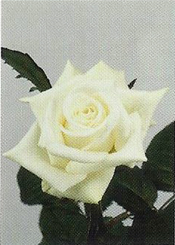





(Akito) (Aqua!) (Passion)
Rosa
Nome Botanico: Rosa.
Famiglia: Rosaceae.
Breve Descrizione: Arbusto a foglia caduca con comportamento variabile secondo le specie. La rosa hybrid ha un portamento eretto, il fusto è lignificato e presenta spine, la corteccia è liscia, verde o rossastra in età giovanile per divenire grigiastra negli esemplari più anziani. Le foglie sono disposte in modo alterno sul fusto e sono di tipo composto, imparipennate. Le foglioline hanno forma ovale-lanceolata e presentano il margine dentellato. Alla base del picciolo ci sono due stipole spesso parzialmente saldate con questo. I fiori sono portati all'estremità dei rami ed all'ascella delle foglie; il primo che compare è sempre quello in posizione terminale, in seguito, nel punto di inserzione delle foglie con il fusto si formano altri fiori o rametti a loro volta ramificati, che portano più fiori. I fiori hanno un involucro regolare e sono ermafroditi, il ricetacolo fiorale è ingrossato, strozzato in alto. La corolla è formata, in molte specie, da 5 petali liberi fra loro, formati da una porzione inferiore, assottigliata, che si allarga all'estremità superiore. La corolla può facilmente diventare doppia; infatti, un certo numero di stami può trasformarsi in altrettanti petali.
Durata: Perenne.
Periodo Di Fioritura: Tra maggio,giugno e settembre.
Area Di Origine: Emisfero boreale, Europa, Asia e America Settentrionale.
Clima: Temperato.
Uso: Come pianta ornamentale nei giardini, per macchie di colore, bordure, alberelli, le sarmentose o rampicanti per ricoprire pergolati, tralicci o recinzioni, le specie nane dalle tinte brillanti e con fioriture prolungate per la coltivazione in vaso sui terrazzi o nei giardini rocciosi. Industrialmente si coltivano le varietà a fusti eretti e fiori grandi, per la produzione del fiore reciso, che occupa in Italia circa 800 ettari, localizzati per oltre la metà in Liguria, il resto in Toscana, Campania e Puglia. I petali vengono utilizzati per le proprietà medicinali, per l'estrazione dell'essenza di Rosa e degli aromi utilizzati in profumeria, nell'industria essenziera, nella cosmetica, pasticceria e liquoristica. È una delle basi immancabili più utilizzate in profumeria. Come pianta medicinale si utilizzano oltre ai petali con proprietà astringenti, anche le foglie come antidiarroico, i frutti ricchi di vitamina C diuretici, sedativi, astringenti e vermifughi, i semi per l'azione antielmintica, e perfino le galle prodotte dagli insetti del genere Cynips ricche di tannini per le proprietà diuretiche e sudorifere. In aromaterapia vengono attribuite all'olio di rosa proprietà afrodisiache, sedative, antidepressive, antidolorifiche, antisettiche, toniche del cuore, dello stomaco, del fegato, regolatrici del ciclo mestruale. Le giovani foglie delle rose spontanee servono per la preparazione di un tè di rosa.
-> Clicca qui per vedere altre varietà... <-
Botanical Name: Rosa.
Family: Rosaceae.
Brief Description: Deciduous shrub with variable behavior depending on the species. The pink hybrid has an upright habit, the stem is woody and has thorns, the bark is smooth, green or reddish at a young age to become grayish in older specimens. The leaves are arranged alternately on the stem and are of a compound type, imparipinnate. The leaves are oval-lanceolate and have a serrated margin. At the base of the petiole there are two stipules often partially welded with this. The flowers are carried at the ends of branches and leaf axils; the first is always the one that appears in the terminal position, then, in the point of insertion of the leaves with the stem are formed other flowers or twigs in turn branched, that bring more flowers. The flowers have a regular envelope and are hermaphrodites, the ricetacolo flowering is swollen, choked up. The corolla is formed, in many species, from 5 free petals between them, formed by a lower portion, thinned, which widens at the upper end. The corolla can easily become double; in fact, a number of stamens can be transformed into many petals.
Duration: Perennial.
Flowering Period: Between May, June and September.
Area Of Origin: Northern hemisphere, Europe, Asia and North America.
Climate: Temperate.
Use: As an ornamental plant in gardens, for splashes of color, borders, trees, the sarmentose or climbing to cover arbors, trellises or fences, the dwarf species from the brilliant hues and blooms with prolonged for growing in pots on the terraces or in rock gardens. Industrially cultivated varieties erect stems and large flowers, for the production of cut flowers, which occupies about 800 hectares in Italy, located in more than half in Liguria, the rest in Tuscany, Campania and Puglia. The petals are used for medicinal properties, for the extraction of the essence of Rose and flavorings used in perfumery, essenziera industry, in cosmetics, confectionery and liquor. It is one of the most unfailing bases used in perfumery. As a medicinal plant are used in addition to the petals with astringent properties, the leaves like antidiarrheal, the fruits rich in vitamin C diuretics, sedatives, astringents and wormers, the seeds for the anthelmintic action, and even the galls produced by insects such Cynips rich in tannins for diuretic and sweat. In aromatherapy are attributed rose oil aphrodisiac, sedative, antidepressant, analgesic, antiseptic, tonic of the heart, stomach, liver, regulating the menstrual cycle. The young leaves of wild roses are used for the preparation of a tea rose.
-> Click here to see more variety... <-
FIORI RECISI / CUT FLOWERS (GEN-FEB-MAR)
FIORI RECISI / CUT FLOWERS (APR-MAG-GIU)
FIORI RECISI / CUT FLOWERS (LUG-AGO-SET)
FIORI RECISI / CUT FLOWERS (OTT-NOV-DIC)